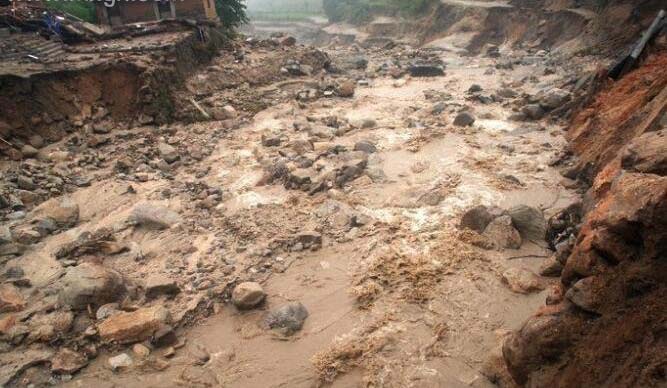Flash floods are among the most dangerous and destructive natural disasters, occurring without much warning and often with devastating consequences. These sudden floods can overwhelm an area within minutes, making it critical for people to understand the risks, heed warnings, and take the necessary precautions to protect themselves and their property. This article will explore the causes of flash floods, the warning signs, and the steps individuals can take to stay safe during such events.
What Is a Flash Flood?
A flash flood is defined as a rapid flooding of low-lying areas—such as rivers, streams, dry lakes, or basins—caused by intense rainfall, dam breaks, or the sudden release of water from a natural or artificial source. What sets flash floods apart from regular floods is the speed at which they occur. While traditional floods may build up over days or weeks, flash floods can happen within a matter of hours, or even minutes, of heavy rainfall or water release.
The areas most susceptible to flash floods are those that are already prone to flooding, such as urban environments with poor drainage systems, arid regions with dry riverbeds, or mountainous areas where water can quickly funnel down slopes. However, flash floods can occur almost anywhere, making it essential to be prepared no matter where you live.
Causes of Flash Floods
Several factors contribute to flash floods, with heavy rain being the primary trigger. Here are some common causes:
- Intense Rainfall: Heavy downpours over a short period can overwhelm drainage systems, rivers, and streams, leading to flash floods. Storms that last less than six hours but release a high volume of water are particularly dangerous.
- Topography: Mountainous areas are especially vulnerable to flash floods because steep slopes allow water to flow downhill quickly. Valleys and low-lying areas can fill up with water rapidly, turning small streams into torrents.
- Urbanization: In cities and urban areas, concrete surfaces like roads and buildings prevent water from being absorbed into the ground. As a result, water flows into drains, often exceeding the capacity of drainage systems, and leads to flooding.
- Dam or Levee Failures: A breach in a dam or levee can unleash a sudden and powerful rush of water, resulting in immediate flash flooding downstream.
- Snowmelt and Ice Jams: In colder regions, rapid snowmelt or ice jams breaking apart in rivers can cause flash floods. These events often occur with little notice, especially during warm spring days following a winter of heavy snowfall.
Understanding Flash Flood Warnings
Flash flood warnings are issued by meteorological agencies when a flash flood is imminent or already occurring. In the United States, the National Weather Service (NWS) uses a multi-tiered system to inform the public about the likelihood and severity of flash flooding:
- Flash Flood Watch: Conditions are favorable for flash flooding, and it’s important to stay alert and prepare for possible evacuation.
- Flash Flood Warning: Flash flooding is either happening or will occur shortly. Immediate action should be taken to protect life and property.
- Flash Flood Emergency: This is the most severe warning, issued only in rare cases where a flash flood poses a significant threat to human life, often in densely populated areas.
Once a warning is issued, it’s crucial to act quickly, as flash floods can develop and intensify rapidly, leaving little time to react.
How to Stay Safe During a Flash Flood
The key to surviving a flash flood is preparation and prompt action. Here are some essential safety tips to keep in mind:
- Stay Informed: Always monitor local news, weather reports, and official alerts for any updates on weather conditions, especially during periods of heavy rain. Having a NOAA Weather Radio or a reliable weather app on your phone can provide timely information even when you’re on the go.
- Evacuate if Necessary: If a flash flood warning or emergency is issued for your area, evacuate immediately. Never ignore evacuation orders, as flash floods can occur with little warning. Move to higher ground and avoid low-lying areas where water collects quickly.
- Avoid Flooded Roads: Never attempt to walk, swim, or drive through flooded areas. Just six inches of fast-moving water can knock a person off their feet, and two feet of water can carry away most vehicles, including SUVs and trucks. The common advice is: “Turn Around, Don’t Drown.”
- Prepare Your Home: If you live in a flood-prone area, take steps to protect your property. Elevate utilities like electrical panels and appliances, and ensure your home’s drainage systems are clear. Consider purchasing flood insurance, as standard homeowners’ insurance typically doesn’t cover flood damage.
- Have an Emergency Kit: Always keep a disaster preparedness kit that includes essentials like non-perishable food, water, first aid supplies, medications, flashlights, batteries, and important documents. Ensure every family member knows the evacuation plan and has access to emergency contact information.
- Be Cautious After the Flood: Even after the water recedes, dangers remain. Floodwaters may contain hazardous chemicals, debris, or raw sewage, so avoid direct contact. Additionally, be wary of weakened infrastructure like roads or bridges that may have been damaged by the flood.
Conclusion
Flash floods are unpredictable and dangerous, capable of causing widespread devastation in a short amount of time. Understanding the causes, recognizing the warning signs, and taking quick, decisive action can save lives and property. By staying informed, having a plan, and respecting the power of water, individuals and communities can better protect themselves from the catastrophic effects of flash floods.
